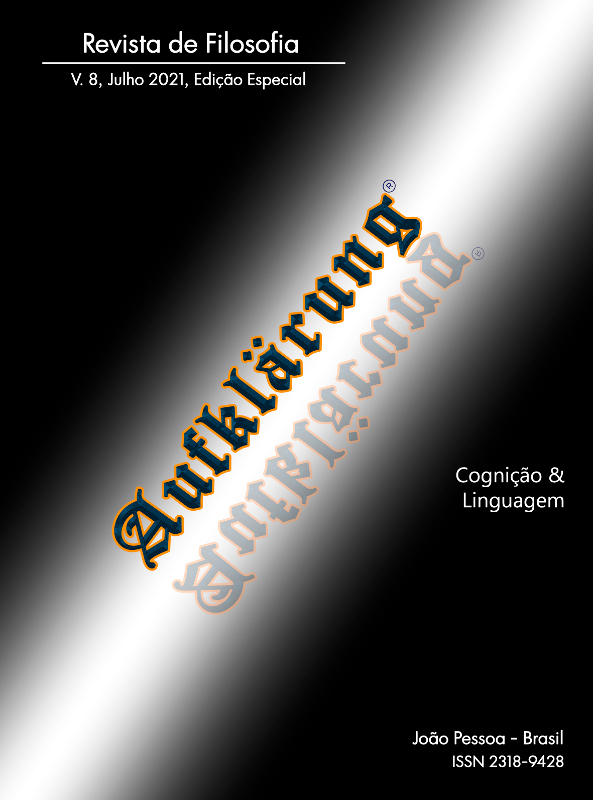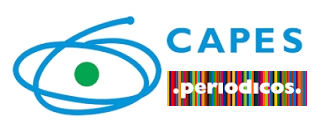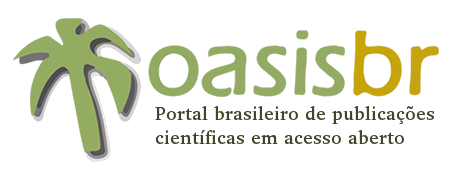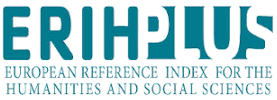A chegada do mais inteligente: A favor de uma explicação pluralista da evolução da cognição
DOI:
https://doi.org/10.18012/arf.v8iesp.60013Keywords:
teorias evolucionistas, adaptacionismo, síntese evolutiva estendida, teorias da mente, cognitivismo, cognição 4EAbstract
Os grandes avanços das últimas décadas, tanto nas teorias cognitivas quanto na biologia evolutiva, ainda não se fundiram totalmente. A maioria das hipóteses evolucionárias em torno da mente ainda se apóia no cognitivismo clássico, enquanto a maioria das teorias da cognição ainda busca explicações adaptativas. Acreditamos que a fusão de novas teorias cognitivas em uma explicação pluralística pode melhorar muito nossa compreensão do que é a cognição e de como ela evoluiu.
Downloads
References
ABZHANOV, A.; PROTAS, M.; GRANT, B. R.; GRANT, P. R.; TABIN, C. J. Bmp4 and morphological variation of beaks in Darwin's finches. Science, v. 305, n. 5689, p. 1462-1465, 2004.
ADAMS, F.; AIZAWA, K. The bounds of cognition. Philosophical Psychology, v. 14, n. 1, p. 43-64, 2001.
ADAMS, F.; AIZAWA, K. (2010), Defending the bound of cognition. In: MENARY, R. (Ed.) The extended mind. Cambridge, MA: The MIT Press, 2010. p. 67-80.
AIROLDI, G. More than fitness: a robustness-based proposal of a logical space to classify processes behind evolutionary phenomena. Kairos: Journal of Philosophy & Science, v. 20, n. 1, p. 89-112, 2018.
AIROLDI, G. The extended mind hypothesis: an anti-metaphysical vaccine. Revista Sofia, v. 8, n. 1, p. 10-29, 2019.
ALTENBERG, L. Modularity in evolution: some low-level questions. In: CALLEBAUT, W.; RASSKIN-GUTMAN, D.; SIMON, H. (Eds.) Modularity: understanding the development and evolution of natural complex systems. Cambridge, MA: The MIT Press, 2005. p. 99-128.
BECHTEL, W. Philosophy of mind: an overview for cognitive science. New York, London: Psychology Press, 1988.
BROOKS, R. A. Intelligence without representation. Artificial Intelligence, v. 47, n. 1-3, p. 139-159, 1991.
BROOKS, R. A. Cambrian intelligence: the early history of the new AI. Cambridge, MA: The MIT Press, 1999.
BROOKS, D. R.; WILEY, E. O. Evolution as entropy. Chicago: The University of Chicago Press, 1986.
CARROLL, L. Alice's adventures in wonderland. Illustrated by John Tenniel. London: Macmillan and Co., 1865.
CELA CONDE, C. J.; AYALA, F. J. Senderos de la evolución humana. Madrid: Alianza Editorial, 2001.
CHANG, F. Symbolically speaking: a connectionist model of sentence production. Cognitive Science, v. 26, n. 5, p. 609-651, 2002.
CHANGEUX, J. P. L'Homme neuronal. Paris: Fayard, 1983.
CHEMERO, A. Radical embodied cognitive science. Cambridge, MA: The MIT Press, 2009.
CHERNIAK, C. Brain wiring optimization and non-genomic nativism. In: PIATTELLI-PALMARINI, M.; URIAGEREKA, J.; SALUBURU, P. (Eds.) Of minds and language: a dialogue with Noam Chomsky in the Basque Country. Oxford: Oxford University Press, 2009. p. 108-119.
CHOMSKY, N. Language and problems of knowledge: the Managua lectures. Cambridge, MA: The MIT Press, 1980.
CLARK, A. Re-inventing ourselves: the plasticity of embodiment, sensing, and mind. The Journal of Medicine and Philosophy, v. 32, n. 3, p. 263-282, 2007.
CLARK, A. Memento’s revenge: the extended mind extended. In: In: MENARY, R. (Ed.) The extended mind. Cambridge, MA: The MIT Press, 2010. p. 43-66.
CLARK, A. Supersizing the mind: embodiment, action, and cognitive extension. Oxford: Oxford University Press, 2011.
CLARK, A.; CHALMERS, D. J. The extended mind. Analysis, v. 58, n. 1, p. 07-19, 1998.
CLUTTON-BROCK, T. H.; HARVEY, P. H. Primates, brains and ecology. Journal of Zoology, v. 190, p. 309-323, 1980.
COSMIDES, L.; TOOBY, J. Beyond intuition and instinct blindness: towards an evolutionarily rigorous cognitive science. Cognition, v. 50, p. 41-77, 1994.
COWAN, W. M.; FAWCETT, J. W.; O'LEARY, D. D.; STANFIELD, B. B. Regressive events in neurogenesis. Science, v. 21, p. 1258-1265, 1984.
DAWKINS, R. The extended phenotype. Oxford: Oxford University Press, 1982.
DEACON, T. W. The symbolic species: the co-evolution of language and the brain. New York; London: W. W. Norton & Co., 1997.
DOBZHANSKY, T. Genetics and the origin of species. 3.ed. New York: Columbia University Press, 1958.
DOR, D.; JABLONKA, E. From cultural selection to genetic selection: a framework for the evolution of language. Selection, v. 1, n. 1-3, p. 33-55, 2000.
DUNBAR, R. I. Brains on two legs: group size and the evolution of intelligence. In: WAAL, F. (Ed.) Tree of origin. Cambridge, MA: Harvard University Press, 2001. p. 173-92.
DUNBAR, R. I., SHULTZ, S. Understanding primate brain evolution. Philosophical Transactions of The Royal Society B: Biological Sciences, v. 362, n. 1480, p. 649-58, 2007.
EDELMAN, G. Neural darwinism: the theory of neuronal group selection. New York: Basic Books, 1987.
FERNANDO, C.; SZATHMARY, E.; HUSBANDS, P. Selectionist and evolutionary approaches to brain function: a critical appraisal. Frontiers in Computational Neuroscience, v. 6, Article 24, p. 01-28, 2013.
FINLAY, B.; DARLINGTON, R. Linked regularities in the development and evolution of mammalian brains. Science, v. 268, p. 1678-1684, 1995.
FISHER, R. A. The genetical theory of natural selection. Oxford: Clarendon Press, 1930.
FODOR, J.; PIATTELLI-PALMARINI, M. What Darwin got wrong. London: Profile Books, 2010.
GALLAGHER, S. How the body shapes the mind. Oxford: Oxford University Press, 2005.
GAZZANIGA, M. S. Right hemisphere language following brain bisection: a 20-year perspective. American Psychologist, v. 38, n. 5, p. 525-537, 1983.
GEARY, D. C. The origin of mind: evolution of brain, cognition, and general intelligence. New York: American Psychological Association, 2004.
GOULD, S. J. The limits of adaptation: is language a spandrel of the human brain? Paper presented to the Cognitive Science Seminar, Center for Cognitive Science. Cambridge, MA: MIT, 1987.
GOULD, S. J. Evolution: the pleasures of pluralism. The New York Review of Books, v. 44, p. 47-52, 1997.
GOULD S. J.; LEWONTIN, S. The spandrels of San Marco and the Panglossian paradigm: a critique of the adaptationist program. Proceedings of the Royal Society B, v. 205, p. 581-598, 1979.
GRAVES, A., WAYNE, G., DANIHELKA, I. Neural Turing Machines. arXiv:1410.5401, p. 01-26, 2014.
GREVE, R. B.; JACOBSEN, E. J.; RISI, S. Evolving neural Turing machines for reward-based learning. Proceedings of the Genetic and Evolutionary Computation Conference, p. 117-124, 2016.
HEALY, S.; ROWE, C. A critique of comparative studies of brain size. Proceedings of the Royal Society B: Biological Sciences, v. 274, n. 1609, p. 453-64, 2007.
HEWES, G. W. An explicit formulation of the relation between tool-using and early human language emergence. Visible Language, v. 7, p. 102-127, 1973.
HOFMAN, M. A. Evolution of the brain in neonatal and adult placental mammals: a theoretical approach. Journal of Theoretical Biology, v. 105, p. 317-322, 1983.
HUMPHREY, N. K. The social function of intellect. In: BATESON, P.; HINDE, R. (Eds.) Growing points in ethology. Cambridge: Cambridge University Press, 1976. p. 303-317.
HUTTO, D.; MYIN, E. Radicalizing enactivism: basic minds without content. Cambridge, MA: The MIT Press, 2012.
HUXLEY, J. Evolution in action. London: Chatto and Windus, 1953.
JACOBS, R. A.; JORDAN, M. I. Computational consequences of a bias toward short connections. Journal of Cognitive Neuroscience, v. 4, n. 4, p. 323-336, 1992.
JABLONKA, E.; LAMB, M. J. Evolution in four dimensions: genetic, epigenetic, behavioral, and symbolic variation in the history of life. Cambridge, MA: The MIT Press, 2005.
JEFFARES, B. The co-evolution of tools and minds: cognition and material culture in the hominin lineage. Phenomenology and the Cognitive Sciences, v. 9, p. 503-520, 2010.
JERISON, H. J. Evolution of the brain and intelligence. New York; London: Academic Press, 1973.
JONAS, D. F.; JONAS, A. D. Gender differences in mental function: a clue to the origin of language. Current Anthropology, v. 16, 626-630, 1975.
KAUFFMAN, S. A. The origins of order: self-organization and selection in evolution. Oxford: Oxford University Press, 1993.
KIMURA, M. The neutral theory of molecular evolution. Cambridge: Cambridge University Press, 1983.
KEIJZER, F.; VAN DUIJN, M.; LYON, P. What nervous systems do: early evolution, input–output, and the skin brain thesis. Adaptive Behavior, v. 21, n. 2, p. 67-85, 2013.
LALAND, K. N.; ULLER, T.; FELDMAN, M. W.; STERELNY, K.; MULLER, G. B.; MOCZEK, A.; JABLONKA, E.; ODLING-SMEE, J. The extended evolutionary synthesis: its structure, assumptions and predictions. Proceedings of the Royal Society B, v. 282, Article 20151019, p. 01-14, 2015.
LANDE, R. Natural selection and random genetic drift in phenotypic evolution. Evolution, v. 30, p. 314-334, 1976.
LANDE, R. Quantitative genetic analysis of multivariate evolution, applied to brain:body size allometry. Evolution, v. 33, n. 1, p. 402-416, 1979.
LASHLEY, K. S. Persistent problems in the evolution of mind. Quarterly Review of Biology, v. 24, p. 28-42, 1949.
LEHMAN, J.; STANLEY, K. O. Abandoning objectives: Evolution through the search for novelty alone. Evolutionary Computation, v. 19, n. 2, p. 189-223, 2011.
LEWONTIN, R. C. Adaptation. In: SOBER, E. (Ed.) Conceptual issues in evolutionary biology. Cambridge, MA: The MIT Press, 1984. p. 235-251.
LEWONTIN, R. C. The evolution of cognition. In: OSHERSON, D. N.; SMITH, E. (Eds.) Thinking: an invitation to cognitive science, Vol. 3. Cambridge, MA: The MIT Press, 1990. p. 229-246.
LINDE-MEDINA, M. Adaptation or exaptation? The case of the human hand. Journal of Biosciences, v. 36, n. 4, p. 575-585, 2011.
LUMSDEN, C. J., WILSON, E. O. Genes, minds, and culture. Cambridge, MA: Harvard university Press, 1981.
LYNCH, M. The frailty of adaptive hypothesis for the origins of organismal complexity. Proceedings of the National Academy of Sciences of the United States of America, v. 104, n. 1 p. 8597-8604, 2007.
LYON, P. The biogenic approach to cognition. Cognitive Processing, v. 7, p. 11-29, 2006.
MAISNIER-PATIN, S.; ROTH, J. R. The origin of mutants under selection: how natural selection mimics mutagenesis (adaptive mutation). Cold Spring Harbor Perspectives in Biology, v. 7, n. 7, a018176, 2015.
MARZKE, M.W. Precision grips, hand morphology, and tools. American Journal of Physical Anthropology, v, 102, p. 91-110, 1997.
MENARY, R. (Ed.) The extended mind. Cambridge, MA: The MIT Press, 2010. (2010a)
MENARY, R. Introduction to the special issue on 4E cognition. Phenomenology and the Cognitive Sciences, v. 9, p. 459-463, 2010. (2010b).
MOCZEK, A. P. On the origins of novelty in development and evolution. BioEssays, v. 30, n. 5, p. 432-477, 2008.
MORGAN, T. H. Evolution and genetics. Princeton, NJ: Princeton University Press, 1925.
MULLER, G. B. Evo-Devo as a discipline. In: MINELLI, A.; FUSCO, G. (Eds.) Evolving pathways: key themes in evolutionary developmental biology. Cambridge: Cambridge University Press, 2008. p. 05-30.
NEANDER, K. Pruning the tree of life. The British Journal for the Philosophy of Science, v. 46, n. 1, p. 59-80, 1995.
NEISSER, U. Cognitive psychology. New York: Appleton-Century-Crofts, 1967.
NEWEN, A.; DE BRUIN, L.; GALLAGHER, S. (Eds.) The Oxford handbook of 4E cognition. Oxford: Oxford University Press, 2008.
NEWNAM, S. A.; FORGACS, G.; MULLER, G. B. Before programs: the physical origination of multicellular forms. International Journal of Developmental Biology, v. 50, p. 289-299, 2006.
NITYAINANDA, V.; READ, J. C. A. Stereopsis in animals: evolution, function and mechanisms. The Journal of Experimental Biology, v. 220, n. 14, p. 2502-2512, 2017.
PARKER, S. T. A social-technological model for the evolution of language. Current Anthropology, v. 26, p. 617-639, 1985.
PIATTELLI-PALMARINI, M. Evolution, selection, and cognition: From "learning" to parameter setting in biology and the study of language. Cognition, v. 31, p. 01-44, 1989.
PIATTELLI-PALMARINI, M., URIAGEREKA, J. Still a bridge too far? Biolinguistic questions for grounding language on brains. Physics of Life Reviews, v. 5, p. 207-224, 2008.
PINKER, S.; BLOOM, P. Natural language and natural selection. In: BARKOW, J.; COSMIDES, L.; TOOBY, J. (Eds.) The adapted mind. Oxford: Oxford University Press, 1992.
RASSKIN-GUTNAN, D.; ESTEVE-ALTAVA, B. Modeling Evo-Devo: broken hierarchies and multiple scales of organization and complexity. AIP Conference Proceedings, v. 167, p. 43-56, 2009.
RAZETO-BARRY, P.; FRICK, R. Probabilistic causation and the explanatory role of natural selection. Studies in History and Philosophy of Biological and Biomedical Sciences, v. 42, n. 3, p. 344-355, 2011.
REEKE, G.; EDELMAN, G. M. Artificial Intelligence. Daedalus, v. 117, n. 1, p. 143-173, 1988.
ROTH, G.; DICKE, U. Evolution of the brain and intelligence. Trends in Cognitive Sciences, v. 9, n. 5, p. 250-257, 2005.
RUPERT, R. D. Challenges to the hypothesis of extended cognition. Journal of Philosophy, v. 101, n. 8, p. 389-428, 2004.
SMOLENSKY, P. Tensor product variable binding and the representation of symbolic structures in connectionist systems. Artificial Intelligence, v. 46, n. 1–2, p. 159-216, 1990.
SPERBER, D. The modularity of thought and the epidemiology of representations. In: HIRSCHFELD, L. A.; GELMAN, S. A. (Eds.) Mapping the mind: domain specificity in cognition and culture. Cambridge: Cambridge University Press, 1994. p. 39-67.
STERELNY, K. Thought in a hostile world: the evolution of human cognition. Malden: Blackwell, 2003.
STERELNY, K. Social intelligence, human intelligence and niche construction. Proceedings of the Royal Society B, v. 362, n. 1480, p. 719-730, 2007.
STERELNY, K. Minds: extended or scaffolded? Phenomenology and the Cognitive Sciences, v. 9, p. 465-481, 2010.
STERELNY, K Culture and the extended phenotype: cognition and material culture in deep time. In: NEWEN, A.; DE BRUIN, L.; GALLAGHER, S. (Eds.) The Oxford handbook of 4E cognition. Oxford: Oxford University Press, 2008. p. 773-792.
STOTZ, K. Human nature and cognitive-developmental niche construction. Phenomenology and the Cognitive Sciences, v. 9, p. 483-501, 2010.
SUTTON, J. (2010). Exograms and Interdisciplinarity. In: MENARY, R. (Ed.) The extended mind. Cambridge, MA: The MIT Press, 2010. p. 189-225.
SYMONS, D. (1992). On the use and misuse of darwinism in the study of human behavior. In: BARKOW, J.; COSMIDES, L.; TOOBY, J. (Eds.) The adapted mind. Oxford: Oxford University Press, 1992. p. 137-162.
TARSITANO, M. S.; JACKSON, R. R. Jumping spiders make predatory detours requiring movement away from prey. Behaviour, v. 131, n. 1-2, p. 65-73, 1994.
THOMPSON, D. On growth and form. 2.ed. Cambridge: Cambridge University Press, 1942.
VARELA, F. J.; THOMPSON, E.; ROSCH, E. The embodied mind: cognitive science and human experience. Cambridge, MA: The MIT Press, 2016.
VECCHI, D. Entrenchment implies that physiological and developmental processes are not organism-bound but still organism-centric. Adaptive Behavior, v. 28, n. 1, p. 33-34, 2019.
VRBA, E. S. The fossil record of African antelopes (Mammalia, Bovidae) in relation to human evolution and paleoclimate. In: VRBA E. S.; DENTON, G. H.; PARTRIDGE, T. C.; BURCKLE, L. H. (Eds.) Paleoclimate and evolution, with emphasis on human origins. New Haven: Yale University Press, 1005. p. 385-424.
WADDINGTON, C. H. Discussion. In: MOORHEAD, P. S.; KAPLAN, M. M. (Eds.) Mathematical challenges to neodarwinian interpretation of evolution. Philadelphia: Wistar Institute, 1967.
WAGNER, A. Arrival of the fittest. New York: Oneworld Publications, 2015.
WHEELER, M. Autopoiesis, enactivism, and the extended mind. Proceedings of the International Conference on the Synthesis and Simulation of Living Systems, v. 11, p. 819, 2008.
WHEELER, M. In defense of extended functionalism. In: MENARY, R. (Ed.) The extended mind. Cambridge, MA: The MIT Press, 2010. p. 245-270.
WILSON, R. A. Boundaries of the mind: the individual in the fragile sciences-cognition. Cambridge: Cambridge University Press, 2004.
WRIGHT, S. The shifting balance theory and macroevolution. Annual Review of Genetics, v. 16, p. 01-19, 1982.
YAMAUCHI, H.; DEACON, T. D.; OKANOYA, K. The myth surrounding the ban by Société de Linguistique de Paris. The Evolution of Language, v. 1, p. 569-570, 2012.
Additional Files
Published
How to Cite
Issue
Section
License

This work is licensed under a Creative Commons Attribution 4.0 International License.
Journal general policy
1.This journal works under a Creative Commons License aplied to online journals. That icence can be read in the following link: Creative Commons Attribution 4.0 International (CC BY 4.0).
2.Accordingly to this License, a)the journal declares that authors hold the copyright of their articles without restrictions, and they can archieve them as post-print elsewhere. b)the journal allow the author(s) to retain publishing rights without restrictions.
Metadata Policy for information describing items in the repository
1. Anyone may access the metadata free of charge at anytime.
2.The metadata may be re-used in any medium without prior permission, even commercial purposes provided the OAI Identifier or a link to the original metadata record are given, under the terms of a CC BY license refered for the Journal.







































